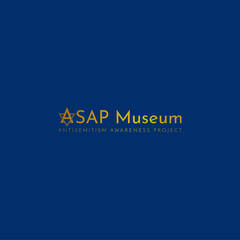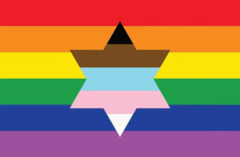how i'm combating antisemitism with asap
11/01/2023 09:30:31 AM

My Story of History. Hate. Hope.
The Star of David pendant I wear nearly every day around my neck is not a traditional six point star. The two triangles joined together are missing parts, so that woven within the design is the letter E, for Emmett. Recast from an old pendant by one of my mother’s closest friends, Susan Cohen - my pendant makes me feel strong and secure, as it gives me a sense of belonging and a feeling of pride for being Jewish. On the days I forget to put it on, I feel noticeably worse. My necklace is how I tell the world, “this is who I am, a proud, confident, Jewish person.” I wish I could write that I feel this way every day. My lack of confidence isn’t in myself, but sadly, in the rest of the world.
For those who don’t know, I moved to Burlingame in the summer of 2022. As a sophomore, I quickly made friends and fell into an easy rhythm. But early in September, the safe community feel was shattered when our school’s principal made an announcement that a swastika had been graffitied in an on-campus bathroom. I was in shock. My whole life I had been taught to be an upstander. But I was having trouble wrapping my head around the gravity of the situation. I kept trying to justify the horrific act, reassuring myself that it was most likely “one dumb kid” and that I didn’t need to worry. But just as the antisemitism at my school started small, so did my subconscious thoughts and actions.
Before Dr. Fong’s announcement, my beloved Magen David was always proudly out on full display in front of my shirt. Despite telling myself I was fine, in moments I felt uncomfortable, I would tuck my Star of David between my shirt and my chest, concealing it from the world. Once the potentially uncomfortable situation had passed, I would again proudly display my pendant.
My ability to pretend that everything was okay ended a few weeks later when posters with Hitler’s face and “Finish the Job” and “We can do it again” decorated my high school. My occasional fear morphed into being outright afraid to go to school. But instead of curling up and hiding, these acts of hate were like a call to action. Coupled with Kanye West’s antisemitic rants on twitter dominating the news, I was at a loss. What could a teenager do to stop white nationalism? How could I fight back?
After making posters with my school's Jewish culture club saying “Never Again Means Never Again” or “Say No to Hate,” I felt slightly placated. Yet there was still a pain in my soul. A few days before my winter finals, one of my closest friends said 3 words to me that would completely change my life. “Hitler was smart.” What did he mean? I asked him that question several times before I walked away, feeling sick to my stomach. Deep down I knew my friend wasn’t hateful, yet during a time of immense antisemitism my friend was incredibly ignorant and insensitive to what was occurring at my school and in our world.
Rather than be afraid of expressing myself with the six-pointed symbol of my people, I realized I needed to be proud of my Jewish identity. While I began to think of how to respond to my friend, I wore my Jewish star front and center once again. Its weight on my chest helped to remind me of the comfort I felt in being Jewish.
After a few days, I finally gained the courage to confront my friend. I expressed to him why what he said was wrong, especially in light of our country’s current antisemitic climate and the conditions at our school. He apologized. However, he also rationalized his thinking, explaining that he needed to “gain skills as a businessman, which Hitler seemed to have.” I realized that his mindset was born from ignorance, not hate.
Through mediation and discussion with the support of my school's administration - who were great partners in facilitating dialogue between us - I learned that my friend had immigrated to America only three years prior, and didn’t know much about the Holocaust. My friend began to understand my family’s history and how his words were a painful reminder of what my family and people had gone through. Throughout the conversation, I stressed how I didn’t want punishment for my friend, but education. Most of all, what I wanted to do was take my friend to a Holocaust museum. Coming from Los Angeles, there is a wealth of educational resources about Jewish life and the Holocaust, however there isn’t a Holocaust museum in the Bay Area. Instead, we both watched Ken Burns’ film “The U.S. and the Holocaust” as well as a Yad Vashem interview of my Great-Grandmother giving a testimonial of her experiences during the Holocaust and as a survivor of multiple concentration camps. To this day, my friend and I are closer than ever, and I am extremely proud to say that he has played a critical part in fighting antisemitism ever since.
A few months later, during a Religious Action Center for Reform Judaism (RAC) trip to Washington DC, I had the privilege of both lobbying U.S. Senate representatives about fighting antisemitism as well as touring the United States Holocaust Memorial Museum. The experience inspired me to want to create a museum that I could use to educate, not just my friend, but anyone who would listen, about the realities of antisemitism and hate. That’s when the seed of ASAP, Antisemitism Awareness Project, was born.

Click image above for more information about ASAP and to make a donation to help the museum expand beyond its showing at PTS
Student-led, the ASAP Museum is a temporary pop-up exhibit that debuts November 9th at Peninsula Temple Sholom. ASAP’s mission is to create awareness and understanding of modern day hate and antisemitism through the lens of the rhetoric, hate, and historical events that led to the Holocaust. The museum’s content is designed to spark conversation and spur action against today’s rising levels of antisemitism and hate.
ASAP’s opening section juxtaposes the actions of modern American hate groups with key moments in history - from WWI through Kristallnacht. The museum goes on to highlight the ADL’s Pyramid of Hate through the atrocities directed towards non-Jewish minorities. The goal is to explain how hate groups begin by reinforcing biases to slowly building their hate and rhetoric until they’re able to get ordinary people to commit violent and ultimately deadly acts. The museum’s third section, Hope, highlights people and organizations who actively combat hate and hate groups. ASAP Museum’s final section, Action, is an interactive experience that gives clear steps of how participants can make a difference.
ASAP Museum’s content is created on easy to reproduce posters, allowing organizations interested in educating about the realities of hate to recreate the experience for their community.
As I look to the future, I do so with hope and determination. While at times, it is scary to share my Jewish star with the world, I know that through education, tenacity, and grit, our world will only become more inclusive. I hope you’ll join me at ASAP’s upcoming debut at PTS.






